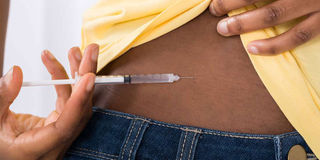How to beat diabetes, without the drugs

What you need to know:
Before I talk about the nutritional alternative, I want to reiterate that diabetes is not a permanent disease, it’s simply a physiological response, and physiological responses can be changed.
People with diabetes actually don’t need medication. The end. This is where you start drafting an email to me saying that I haven’t done my research, it can’t possibly be true, and that if, by some stretch of imagination, it were true, then people would be doing it to save themselves a lifetime on medication, not to mention the heart disease and other ailments that invariably follow. But I have done my research, and with the world market for diabetes drugs believed to be $55.3bn in 2017 (up from $35.6bn in 2012), you can see why no one wants to talk about this. Before I talk this seemingly magic solution for the 700,000-plus Kenyan adults and 25,000 children suffering from diabetes, I want to explain very clearly what diabetes is. Its official name is diabetes mellitus, the term ‘diabetes’ meaning excessive urination, and the word ‘mellitus’ meaning honey. When one is literally urinating out sugar, there’s an important sequence of events that isn’t working as it should in the body.
In Type 1, or insulin dependent, diabetes, the pancreas no longer produces insulin, and so Type 1 diabetics end up giving themselves insulin injections for life to ensure their blood sugar stays within a desirable range (more about insulin soon). Type 1 diabetes occurs either due to injury, infection or an autoimmune condition (this is when the body starts attacking itself) and typically shows up before early adulthood.
Type 2 diabetes is a completely different condition. It’s actually a complex, metabolic condition. This means that there are abnormal chemical reactions going on in the body, and it is this that leads to problems handling glucose and what’s known as insulin resistance. For most Type 2 diabetics, although they’re able to make insulin, the cells of the body, particularly those in the liver and the muscles, can’t actually get at the glucose, so levels in the blood get too high.
Imagine a locked door that needs to be opened to let sugar into the cells. Insulin is the key here. The term ‘insulin resistance’ means that the lock is either blocked or damaged, so that the key, insulin, no longer opens it.
Effects
Since sugar can’t get into the cell, it builds up outside it, in the bloodstream, and causes all sorts of damage. And when blood sugar levels are high, it can be toxic. It leads to a process called glycation, which is almost as if all the blood vessels of the body have been caramelised. It mainly affects the blood vessels in the eyes, the feet, the kidneys and the endothelium (the inside lining of blood vessels around the heart) and this is what leads to the complications associated with diabetes.
So the way medication for Type 2 diabetes works, is to either increase sensitivity to insulin (they try to repair the lock) or enhance insulin production (you can see why having more keys may not necessarily work). But it’s the side effects of many long-term drugs that worry me.
For example, the most widely used drug, Metformin, frequently causes nausea, cramps, vomiting and loose stools, and knocks out vitamin B12, which is important in the formation of red blood cells and the maintenance of a healthy nervous system.
Before I talk about the nutritional alternative, I want to reiterate that diabetes is not a permanent disease, it’s simply a physiological response, and physiological responses can be changed.
I did it, and so can you
After being diagnosed with gestational diabetes in all three of my pregnancies, I adopted the mantra “three meals a day, with nothing in between” other than water. This not only improves the body’s sensitivity to insulin, but to leptin and ghrelin too. Leptin and ghrelin are the hormones that regulate appetite and are found in our fat. Leptin is the hormone that tells us when we’re full, so when leptin levels are out of balance, we don’t feel satisfied after a meal. On the flip side, ghrelin tells us when we are hungry. If your hormones are balanced, when ghrelin levels increase, you eat, and then, as you become fuller and more satisfied, your leptin levels increase and you stop eating. When you are leptin-resistant, you’re likely to feel hungry after meals and spend the day craving carbohydrates and/or sugar. In order to allow your body to reset itself and become more sensitive to these hormones, it’s important to go long periods of time without eating. Not getting enough sleep also affects these two hormones adversely. But haven’t we all been told to snack in order to balance our blood sugar? Well, by eating more regularly, your body becomes dependent on sugar rather than stored fat for energy. Furthermore, every time you eat, you’re increasing inflammation in the body due to the insulin that is released. So stick to the three meals. It works.
Staying active or the gym
Despite what many would have us believe, exercise does not reverse the harmful effects of sitting. In fact, studies show that taking breaks from sitting throughout the day has a greater effect on insulin sensitivity and glucose control than doing distinct periods of exercise a few times a week. So punctuate your day with non-exercise physical activity, whether it’s taking the stairs, going for a walk round the office when working on an important assignment, or just taking regular loo breaks.
You snooze, you lose
Did you know that just one night of poor sleep can lead you to make poorer food choices, consume more and lay down fat more easily? A study published in the Annals of Internal Medicine found that reducing sleep to just 4-5 hours a night for just four consecutive nights reduced insulin sensitivity by a third, and this is exactly what leads to type 2 diabetes. Ideally, you should be in bed by 10pm, at least five nights a week. Interestingly, it’s not about how much you sleep, but about when — something that I’ve experienced first-hand with my patients (working at night or doing shift work, makes it extremely difficult to get blood sugar under control).
De-stress, it’s easier than you think
Stress is a major contributing factor to Type 2 diabetes as well as most other chronic diseases. Finding ways to de-stress on a regular basis is probably the single most important thing you can do for your health. I find breathing techniques, meditation and yoga help enormously. The breathing is particularly beneficial, as just ten, long, slow, deep breaths can fool the brain into thinking it’s relaxed.
That blood pressure pill
Did you know that hypertension is directly related to insulin resistance? You see, even though insulin stops working that well on skeletal muscle and fat tissue, it continues to works on the kidneys, which then reabsorb sodium and water, which in turn puts up blood pressure. But since blood sugar continues to rise, this begins to adversely affect the arteries. It starts with the smaller arteries, working up to the larger ones and when the aorta starts to get stiff it affects the systolic pressure. This is what we call ‘oxidative stress’.
Exhibit A
And with that, enter exhibit A: the gorillas at Cleveland Metropark Zoo in the US. We know that wild gorillas don’t get diabetes, but the captive ones, with their daily ‘nutritional cookies’ filled with starch and sugar, do. When the diets of the gorillas in the zoo were changed to include greens, seeds, berries, bamboo, the gorillas lost 30 kilogrammes and reversed diabetes and heart disease. So, how do we go about recalibrating the body in humans? Well, the good news is that it can take as little as eight weeks, assuming you’re willing to do the work. And the work involves, in part, learning a little bit about easily digestible carbohydrates, something that many dietitians will encourage diabetics to eat. What we now know is that foods like bread, rice, pasta and potatoes are rapidly absorbed in the body. This creates an instant spike in blood sugar levels, which then go on to crash, not only making you hungry again, but also eventually causing your body to stop listening to insulin, the hormone that regulates our blood sugar. It’s exactly this insulin resistance that contributes to the build-up of fat in the liver and pancreas, which in turn causes all the problems associated with diabetes.
Cut down on carbs
So if we want to cut down on these carbs, what exactly does that look like? Well, ideally we want about 100 grammes a day, and the picture shows you exactly what you can get for about 20 grammes. Starchy vegetables like white potato, corn and cooked carrots also fall into this category. So, we want to get most of our carbs from fibrous (broccoli, cauliflower, asparagus, green leafies) and salad vegetables (bell peppers, cucumbers, celery, tomato). Nuts and seeds, low-glycaemic fruits (berries, apples, plums, watermelon), and small amounts of beans and legumes can also count. Once you get used to doing this, you can experiment with lowering the amount of carbohydrate you eat even more. Ultimately, you want to be down to less than 50 grammes a day, for optimal blood sugar control. Fewer carbs forces the body to burn fat faster too. Next up, protein. To my mind, protein is truly a wonderfood, because it makes you feel full after you’ve eaten it (it’s high on the satiety index). Despite this, don’t overdo it. I find that a good amount of protein for the average person is about 100 grammes of animal protein per meal. Good sources of quality protein include beef, pork, free-range poultry, seafood, nuts and seeds, low-glycaemic beans and legumes, and non-GMO soya.
What about fat?
Well, the good ones aren’t something that you should be afraid of, at all. While fatty coldwater fish like salmon isn’t readily available to most Kenyans, avocados most definitely are. And if you can get in nuts, seeds, olives and olive oil, that’s an added bonus. Free-range eggs, and butter, or ghee, are also good. Sounds like we’re all set? Not quite. Too much of a good thing, even the ‘real’ food that I’m advocating here, is still too much, so reducing the amount you eat is also important. Anything that’s not burnt off simply gets converted to sugar and ultimately stored as fat. I have found that reducing calorie intake by about a quarter can have an enormous effect on blood sugar and weight control.
The writer is a clinical nutritionist and certified by the Nutritional Therapy Council in the UK.


